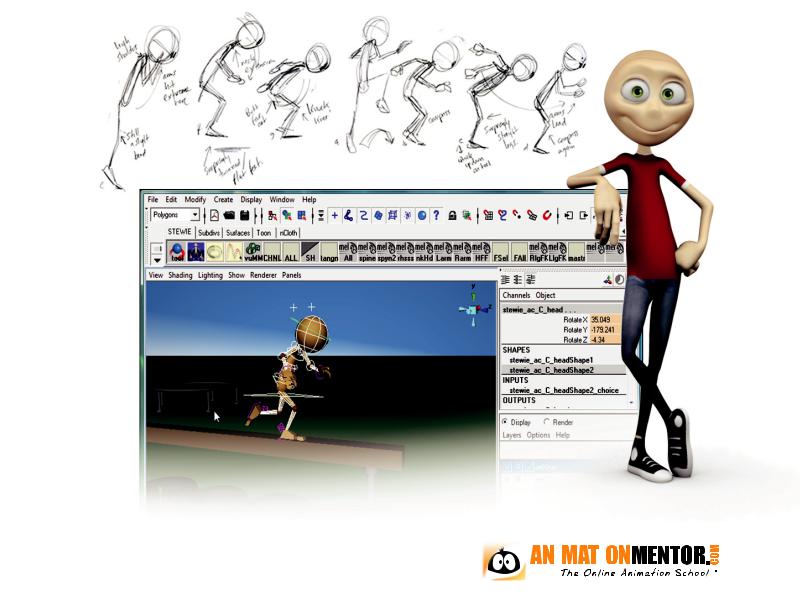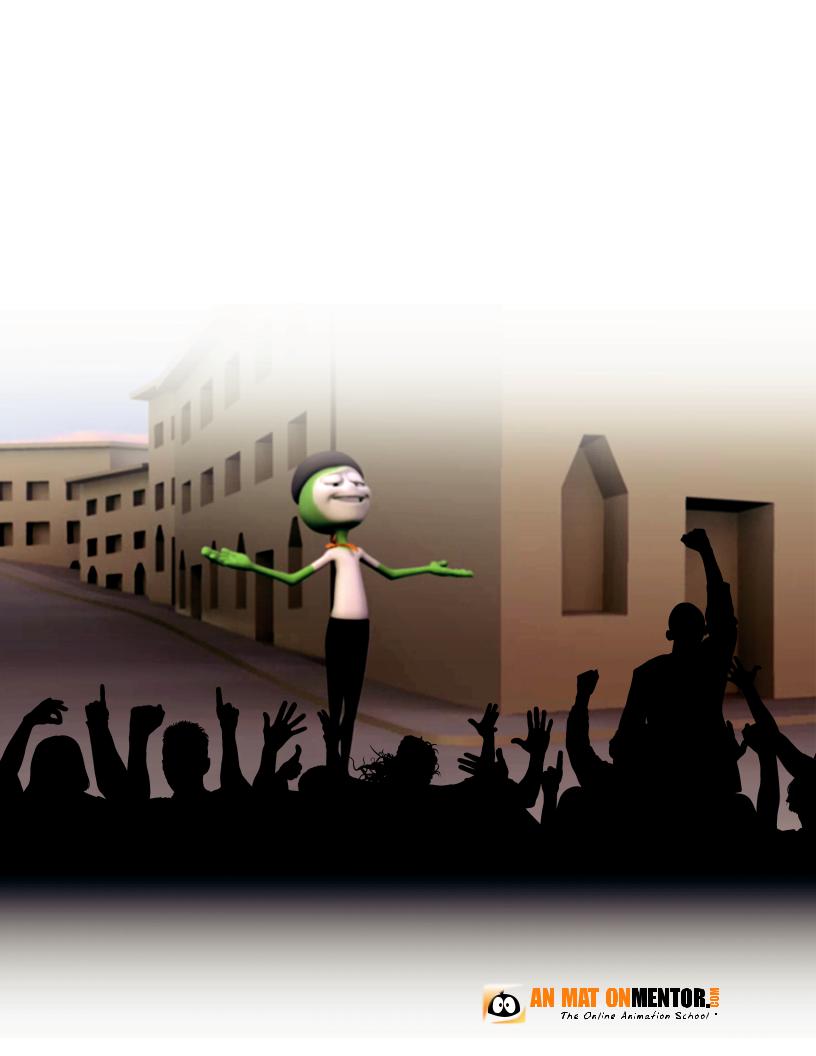
AnimationMentor_HowToBecomeAnAnimator
.pdf
Other job titles include:
• |
Animation Director |
• |
Layout Artists |
• |
Texture Artist |
• |
Animator |
• |
Layout Technical Director (TD) |
• |
Video Game Animator |
• |
Art Director |
• |
Modeling Supervisor |
• |
Video Game Artist |
• |
CG Supervisor |
• |
Modeling TD |
• |
Video Game Designer |
• |
Character Designer |
• |
Pre-Vis Artist |
• |
Video Game Engineer |
• |
Cloth Simulation Artist |
• |
Producer |
• |
Video Game Producer |
• |
Compositor |
• |
Production Assistant |
• |
Video Game Programmer |
• |
Concept Artist |
• |
Rigging Supervisor |
• |
Video Game Technical Director |
• |
Creative Director |
• |
Rigging TD |
• |
Visual Effects Supervisor |
• |
Effects Designer |
• |
Roto Artist |
• |
Water FX Artist |
• |
Environment Designer |
• |
Shading TD |
|
|
• |
Fur/Feathers FX Artist |
• |
Shading/Texture Supervisor |
|
|
The best way to get information about specific skills and requirements for various types of animation jobs is to keep an eye on job listings. Most spell out the requirements in great detail along with any specialized training or experience that might be necessary. You can find job listings on Animation World Network’s job posting section at http://jobs.awn.com/home/index.cfm?site_id=500. You can also find jobs on Creativeheads.net and on CG Society’s job section: http://jobs.cgsociety.org/. Last, but not least, all the studios and game development companies post job listings on their websites. For specialized jobs in the medical, law enforcement or architectural industries, you will need to do some targeted keyword searches.
“The creative freedom is inspiring, enlightening and makes working
as an animator that much more enjoyable.
“
Copyright 2009 by AnimationMentor.com. All rights reserved. This eBook may not be reprinted |
|
|
|
4 |
|
|
|||
|
|
|
|
|
or distributed in electronic, print, web, or other format without express written permission. |
|
|
|
|
|
|
|
|

CLARIFY YOUR GOALS
When planning your future, it’s a good idea to think about what it is you like and dislike about certain jobs before you spend a lot of time and effort trying to get one. You are about to invest your time and money in an education that will launch you into a career that you hope to enjoy. Now is the time to think about
what you want to achieve in the next few years.
Most people have many types of goals, including professional, personal, financial, health and fitness and lifestyle.
Make sure that whatever career you choose will support and accommodate all of these areas of your life.
One good way to do this is to find people who are doing the types of jobs you are interested in, and read about them or interview them. Read books written by animators, go to seminars where you can ask questions, research them on forums and blogs and see what they have to say about what they do. If possible, find someone with the exact job title in the type of company or studio you want to work in
and see if they will give you 10-15 minutes of their time for an informational interview. You can ask them specifically what they do and how they occupy their day in order to see if the reality of a particular job measures up to your expectations.
“The best thing about animation is working with really great, highly intelligent, fun and creative people.
“
It’s always good to write down your goals and refine them as you gather more information and experience, and get clearer about what it is you want.
According to almost every goal-setting guru out there, writing down your goals gives you a much higher chance of achieving them.
A 1979 Harvard MBA program survey asked students,“Have you set clear, written goals for your future and made plans to accomplish them?” Only 3% of the graduates had written goals and plans; 13% had goals, but they were not in writing; and 84% had no specific goals. Ten years later, the members of the class were interviewed again, and the finding showed the 13% of the class who had goals were earning, on average, twice as much as the 84% who had no goals at all. And what about the 3% who had clear, written goals? They were earning, on average, 10 times as much as the other 97% put together.
Not all goals have to be about making money. They could also be about learning new skills, creating great art, or running a marathon. What goals have in common is a vision of what you want to be, do, or have in the future.
“ I like working on interesting and exciting projects, and having the opportunity to learn and expand
my skill as a designer/animator from colleagues.
“
Copyright 2009 by AnimationMentor.com. All rights reserved. This eBook may not be reprinted |
|
|
|
5 |
|
|
|||
|
|
|
|
|
or distributed in electronic, print, web, or other format without express written permission. |
|
|
|
|
|
|
|
|

LOOK AT WHERE YOU ARE NOW
Are you clear about exactly what type of animation you want to specialize in, or are you still exploring different areas of animation, art and design?
If you know exactly what you want to do, then find the school that offers that specific type of training.
If you are still not sure of the area you want to work in, perhaps a general animation university or art college that lets you sample a variety of art and animation classes would be a better step at this point in your education. In fact, this is often a great way to get a basic education that you can then expand on with specialized studies once you develop a focus and a passion for a specific area of expertise within the animation field.
Some other things to think about
What experience and education do you already have? Do you have a portfolio or demo reel? Some schools want to see your work
– or know that you have some education and interest in an area – before they will admit you to their program. Can you show them work you’ve done in high school through hobbies or work experience? If you are just starting, you may want to consider working on a project or two on your own, or through a local adult education class to beef up your skills and also build your confidence in this area.
Are you willing to leave home to pursue your education? If not, an online school may be your best bet.
What is your financial situation? Will you need to work while attending school? Will the school you attend allow you the flexibility to do this while you study?
Copyright 2009 by AnimationMentor.com. All rights reserved. This eBook may not be reprinted |
|
|
|
6 |
|
|
|||
|
|
|
|
|
or distributed in electronic, print, web, or other format without express written permission. |
|
|
|
|
|
|
|
|

CREATE A PLAN
Now that you know what you want, and you understand where you are on your journey, you can create a map that will get you to your goals. The next step in the process is to create an action plan of specific steps you need to move closer to reaching your dreams.
Commit to taking action every day to move closer to your goals. Soon you will find that simply writing goals and action items, taking action, and keeping track of your results will help you focus on what you want, and you’ll achieve more in your life.
You’ll better understand your priorities and see which activities and pursuits are helping you achieve your goals and which ones are irrelevant, unimportant, or a distraction. You will also find a plan to be a source of motivation, and a way to build selfconfidence as you see yourself getting closer to your goals.
Copyright 2009 by AnimationMentor.com. All rights reserved. This eBook may not be reprinted |
|
|
|
7 |
|
|
|||
|
|
|
|
|
or distributed in electronic, print, web, or other format without express written permission. |
|
|
|
|
|
|
|
|

RESEARCH SCHOOLS TO FIND THE
BEST FIT FOR YOU
QUESTIONS YOU SHOULD ASK:
What skills does the school teach specifically?
As noted, there are many specific areas of expertise within the field of animation. Be sure the school you are considering teaches the specific type of animation skills you will need to succeed in your career choice.
What is the school’s focus?
Even within different areas of animation, you will find a variety of skill sets. Find the school that has the same focus you want to specialize in. For example, if you would like to work on animated
features for a studio, you would want to specialize in character animation,
and select a school such as Animation Mentor that specifically specializes in that art.
How good is the curriculum?
One way to judge a curriculum is to look at the student work and see where their graduates are working. If their graduates are working in the types of jobs you are interested in, and the student demo reel rocks, then you know this is the school for you.
Who teaches the courses – do they have real-world experience?
Make sure you are learning from professionals who are actually working in the type of environment you want to be working in. They will teach you the tricks of the trade and give you the skills you need to succeed on the job.
What is the learning/teaching model like?
Think about what the learning experience will be like. If you choose a brick and mortar college, you will have to physically attend class to get the live lecture that’s only presented once. If you are sick or unable to get to class, you will miss it. You will also not be able to watch it over and over again until you thoroughly understand it. If you are attending an online school that uses video lecture and live Q&A technologies, you will be able to view lectures as often as you like and have one-on-one interactions with your instructors on a regular basis. In addition, look at the type of individual attention you get on your work. Will your work be regularly critiqued so that you can learn to improve it? Often in brick and mortar schools, the instructor only has time to critique one or two students per week. At Animation Mentor, each student gets an individual critique from a professional animator every week.
Copyright 2009 by AnimationMentor.com. All rights reserved. This eBook may not be reprinted |
|
|
|
8 |
|
|
|||
|
|
|
|
|
or distributed in electronic, print, web, or other format without express written permission. |
|
|
|
|
|
|
|
|

How long does it take to complete the program?
If you are looking for a degree and a general education, this may not be an issue for you. If you are looking for specific training that will help you land a job in the industry, you may want to complete the training in less than four years. Consider what type of program will best fit your lifestyle and finances.
Does the school help you find a job?
What type of job placement assistance does the school provide? Do big name recruiters visit the school and place graduates? Where do their graduates work and what are the typical entry-level jobs they are placed in? What is the school’s job placement rate? These are all questions you should consider before making a final decision.
Will you graduate with a good demo reel?
The No. 1 requirement for landing a job in the animation industry is a good demo reel. This is a short video of all your best work. It can be as short as 15-30 seconds and should show only your absolute best work and the specific type of animation work you want to specialize in. For more specific information about what recruiters look for in a demo reel, please see Carlos Baena’s Webinar and article on the subject. Regardless of the school you choose, be sure that the main focus of your studies is the creation of a strong animation-specific demo reel that will help you land a job.
“ When your work makes people laugh
or smile or just gives them a few moments
of uninterrupted joy, that makes it all worthwhile.
“
Copyright 2009 by AnimationMentor.com. All rights reserved. This eBook may not be reprinted |
|
|
|
9 |
|
|
|||
|
|
|
|
|
or distributed in electronic, print, web, or other format without express written permission. |
|
|
|
|
|
|
|
|

ABOUT
ANIMATION MENTOR
Animation Mentor was founded with the sole purpose of providing the most fulfilling learning experience on the planet to students who want to learn character animation and work as animators on feature films.
MENTOR MODEL AND SOCIAL NETWORKING
In addition to teaching character animation skills, Animation Mentor believes the best way to learn is from a mentor who is working on the types of projects you want to work on. Their instructors are all working animators who work at studios like Pixar Animation Studios, Industrial Light & Magic (ILM), DreamWorks, Disney, and a variety of entertainment and gaming studios. In addition, the online campus is designed for maximum exposure to mentors and other students so that attendees can network, make friends, share work, and collaborate on ideas.
We conducted a survey in which professional animators said having a mentor is one of the best ways to grow as an animator. Our survey also recommends making industry connections, and gaining the skills to be production-ready so that you can go to work in the industry. Choosing the right animation school is an important investment in a student’s future that can pay big dividends in the long run.
RETURN ON INVESTMENT
Given the high cost of education in today’s market and the current economic climate, it’s no accident that Animation Mentor places a high priority on keeping tuition costs affordable, and works to place students in jobs that will help launch themselves into successful animation careers. Animation Mentor’s job placement rate is 78% worldwide.
Our online program connects students from around the world with top professional animators, with an emphasis on learning how to work in a production environment. Our goal was to develop an education that would make people job-ready in only 18 months at a cost they could pay back in just a year or two.
We think the onerous debt many college graduates are facing is overwhelming. Our goal is to get our graduates earning money and getting free of debt as quickly as possible.
WORKING WITH STUDIOS
Animation Mentor works with all the major studios, game companies, and independent studios to help place graduates into jobs. Because we spend a lot of time networking with recruiters and hiring departments, we’ve learned a few things about what they are looking for.
Copyright 2009 by AnimationMentor.com. All rights reserved. This eBook may not be reprinted |
|
|
|
10 |
|
|
|||
|
|
|
|
|
or distributed in electronic, print, web, or other format without express written permission. |
|
|
|
|
|
|
|
|

The big studios want to hire specialists who are excellent at one specific skill. They don’t want generalists who are just “okay” at a lot of different things. Because they have teams of artists working on projects, each member of the team must be outstanding in his or her particular discipline such as animation, lighting, rigging, or texturing, for example. When applying to a large studio, be clear about your specialty or they won’t consider you.
Independent studios, smaller studios and game companies who don’t have large teams of people are more likely to seek someone who is more of a generalist and who has a varied skill set. For example, instead of just doing character animation all day, an employee may also need to be able to do rendering and lighting, too. This is usually a great fit for someone who is new and starting out in the industry and wants to explore a couple of different areas of expertise.
Studios and game developers alike are also looking for well-rounded people who have an interest and knowledge of the world around them. They want someone who can not only animate, but who can also bring something extra to the character or story. They like to see people who can draw references from movies, art, literature and current events, and who are informed, and well-read.
“The great thing about being an animator
is that you never stop learning!
“
Copyright 2009 by AnimationMentor.com. All rights reserved. This eBook may not be reprinted |
|
|
|
11 |
|
|
|||
|
|
|
|
|
or distributed in electronic, print, web, or other format without express written permission. |
|
|
|
|
|
|
|
|

LEARNING RESOURCES
There are many great publications and websites available to learn more about animation and the animation industry.
AnimationMentor.com has a Resources section on its website with links to its favorite sites, along with industry reports and webinars for those exploring a future career in animation.
Some other great sites include:
•www.11secondclub.com
•www.3dtotal.com
•www.animationarena.com
•www.animationmagazine.net
•www.animationpodcast.com
•www.animationtipsandtricks.com
•www.awn.com
•www.blendernation.com
•www.bobbyboomblogspot.com
•www.carlosbaena.com
•www.cartoonbrew.com
•www.cgsociety.org
•www.cgw.com
•www.digitalcontentproducer.com
•www.jasonryananimation.com
•www.postmagazine.com
•www.vfxworld.com
SUGGESTED READING
ANIMATION CAREER REFERENCES
Animation Tips and Tricks Volume I by Shawn Kelly
Animation Tips ad Tricks, Volume II by Animation Mentor Founders and Mentors Shawn Kelly, Carlos Baena, Keith Sintay, Aaron Gilman and Wayne Gilbert
Cracking Animation: The Aardman Book of 3D Animation by Peter Lord and Brian Sibley
How to Get a Job in Computer Animation by Ed Harriss
Copyright 2009 by AnimationMentor.com. All rights reserved. This eBook may not be reprinted |
|
|
|
12 |
|
|
|||
|
|
|
|
|
or distributed in electronic, print, web, or other format without express written permission. |
|
|
|
|
|
|
|
|

GENERAL ANIMATION
Ray Harryhausen: An Animated Life by Ray Harryhausen and Tony Dalton
Animation: From Script to Screen by Shamus Culhane*
Cartoon Animation (The Collector’s Series) by Preston Blair*
Cartooning: Animation 1 with Preston Blair (HT26) by Preston Blair*
Cartooning: Animation 2 with Preston Blair (HT190) by Preston Blair*
Character Animation Crash Course! by Eric Goldberg
Drawn to Life: 20 Golden Years of Disney Master Classes, Volumes I and II: The Walt Stanchfield Lecture by Walt Stanchfield, edited by Don Hahn
Inspired 3D Short Film Production by Pepe Valencia and Jeremy Cantor*
The Animator’s Survival Kit by Richard Williams*
The Complete Animation Course: The Principles, Practice, and Techniques of Successful Animation by Chris Patmore
The Illusion of Life by Frank Thomas and Ollie Johnston*
Timing for Animation by Harold Whitaker and John Halas*
Treasures of Disney Animation Art by John Canemaker*
ANATOMY, DRAWING, AND BODY LANGUAGE
An Atlas of Animal Anatomy for Artists by W. Ellenberger, H. Baum, H. Dittrich and Lewis S. Brown
Atlas of Human Anatomy of the Artist by Stephen Rogers Peck
An Atlas of Anatomy for Artists by Fritz Schider
Drawing on the Right Side of the Brain by Betty Edwards*
Manwatching: A Field Guide to Human Behavior by Desmond Morris *
Simplified Drawing for Planning Animation by Wayne Gilbert*
Teach Yourself Body Language by Gordon Wainwright*
The Artist’s Complete Guide to Facial Expression by Gary Faigin*
The Natural Way to Draw by Kimon Nicolaides*
Copyright 2009 by AnimationMentor.com. All rights reserved. This eBook may not be reprinted |
|
|
|
13 |
|
|
|||
|
|
|
|
|
or distributed in electronic, print, web, or other format without express written permission. |
|
|
|
|
|
|
|
|
